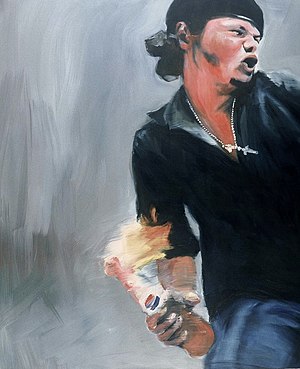
Susan Meiselas is an American documentary photographer. She has been associated with Magnum Photos since 1976 and been a full member since 1980. Currently she is the President of the Magnum Foundation. She is best known for her 1970s photographs of war-torn Nicaragua and American carnival strippers.

Nancy Spero was an American visual artist. Born in Cleveland, Ohio, Spero lived for much of her life in New York City. She married and collaborated with artist Leon Golub. As both artist and activist, Nancy Spero had a career that spanned fifty years. She is known for her continuous engagement with contemporary political, social, and cultural concerns. Spero chronicled wars and apocalyptic violence as well as articulating visions of ecstatic rebirth and the celebratory cycles of life. Her complex network of collective and individual voices was a catalyst for the creation of her figurative lexicon representing women from prehistory to the present in such epic-scale paintings and collage on paper as Torture of Women (1976), Notes in Time on Women (1979) and The First Language (1981). In 2010, Notes in Time was posthumously reanimated as a digital scroll in the online magazine Triple Canopy. Spero has had a number of retrospective exhibitions at major museums.
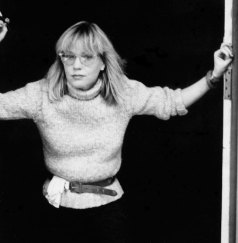
Sarah Edwards Charlesworth was an American conceptual artist and photographer. She is considered part of The Pictures Generation, a loose-knit group of artists working in New York in the late 1970s and early 1980s, all of whom were concerned with how images shape our everyday lives and society as a whole.
Dana Schutz is an American artist who lives and works in Brooklyn, New York. Schutz is known for her gestural, figurative paintings that often take on specific subjects or narrative situations as a point of departure.
Deb Sokolow is an American visual artist who lives and works in Chicago. Sokolow's work uses both image and text to conjure connections among historical events, celebrities, politicians, and her own personal history in order to spur new consideration of alternate possible realities. Her work has been exhibited widely and is part of a number of permanent collections, including the Hirshhorn Museum and Sculpture Garden, the Los Angeles County Museum of Art, Chicago's Museum of Contemporary Art, the Scottsdale Museum of Contemporary Art, and the Spertus Museum.
Carrie Mae Weems is an American artist working in text, fabric, audio, digital images and installation video, and is best known for her photography. She achieved prominence through her early 1990s photographic project The Kitchen Table Series. Her photographs, films and videos focus on serious issues facing African Americans today, including racism, sexism, politics and personal identity.
In art, appropriation is the use of pre-existing objects or images with little or no transformation applied to them. The use of appropriation has played a significant role in the history of the arts. In the visual arts, "to appropriate" means to properly adopt, borrow, recycle or sample aspects of human-made visual culture. Notable in this respect are the readymades of Marcel Duchamp.
Judy Pfaff is an American artist known mainly for installation art and sculptures, though she also produces paintings and prints. Pfaff has received numerous awards for her work, including a John D. and Catherine T. MacArthur Foundation Fellowship in 2004 and grants from the John Simon Guggenheim Memorial Foundation (1983) and the National Endowment for the Arts. Major exhibitions of her work have been held at the University of Wisconsin–Madison, the Denver Art Museum and Saint Louis Art Museum. In 2013 she was elected to the American Academy of Arts and Sciences. Video interviews can be found on Art 21, Miles McEnery Gallery, MoMa, Mount Holyoke College Art Museum and other sources.
An art blog is a common type of blog that comments on art. More recently, as with other types of blogs, some art blogs have taken on 'web 2.0' social networking features. Art blogs that adopt this sort of change can develop to become a source of information on art events, a way to share information and images, or virtual meeting ground.

Mira Schor is an American artist, writer, editor, and educator, known for her contributions to critical discourse on the status of painting in contemporary art and culture as well as to feminist art history and criticism.
Marylyn Dintenfass is an American painter, printmaker, and sculptor. She is primarily known for her oil paintings, which use a dynamic color palette and lexicon of gestural imagery to explore dualities in the human experience and everyday sensual pleasures.

Tameka Norris, also known as T.J. Dedeaux-Norris and Meka Jean, is an American visual and performing artist. Norris uses painting, sculpture, and performance art to create work about racial identity and the simultaneous visibility and invisibility of blackness through cultural appropriation in modern society. Her work critiques the presence of the Black body in the history of painting and fine art.
Laylah Ali (born 1968) is a contemporary visual artist known for paintings in which ambiguous race relations are depicted with a graphic clarity and cartoon strip format.
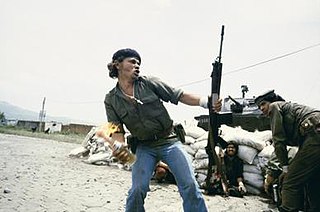
Molotov Man is the title by which a photograph taken by Susan Meiselas during the 1979 Nicaraguan Revolution has come to be known. Famous in its Nicaraguan context as a symbol of the Sandinista revolution, it has been widely reproduced and remixed.

Candida Alvarez is an American artist and professor, known for her paintings and drawings.
Lisa Park is a Korean-American artist and a full-time lecturer in the Fine Arts & Design department of the Stuart Weitzman School of Design at the University of Pennsylvania. She has previously resided in both New York City and Seoul but is currently based in Philadelphia, United States.
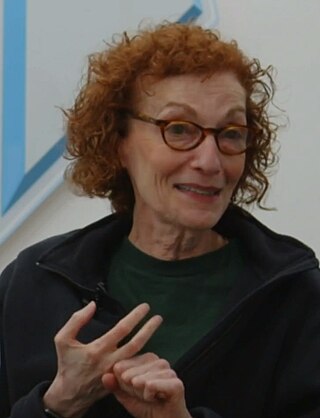
Beverly Fishman is an American painter and sculptor whose work explores science, medicine, and the body. She is a Guggenheim Fellow, a National Academy of Design Academician, an Anonymous Was a Woman awardee, and was Artist-in-Residence at Cranbrook Academy of Art between 1992 and 2019, where she was Head of the Painting Department. Although best known for her painted reliefs based on the forms of drugs and pharmaceuticals, Fishman has consistently worked in multiple media, such as cast-resin and glass sculpture, as well as silkscreen painting on metal, large-scale wall painting, and outdoor murals. While Fishman's artworks often look abstract, they are based on appropriated shapes, patterns, and images drawn from the pharmaceutical and illicit drug industries as well as multiple forms of scientific and medical imaging. As she noted in 2017, "Although they look abstract, my paintings are tied to problems like attention-deficit disorder, opioid addiction, anxiety, and depression. Their forms connect them to the social problems of today."
Avery Singer is an American artist known for creating digitally assisted paintings created through 3D modeling software and computer-controlled airbrushing.
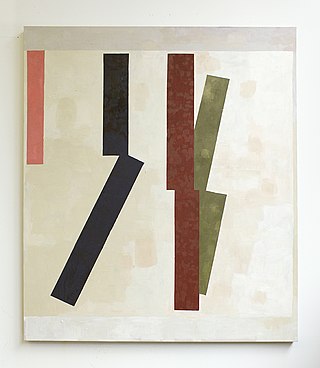
Sharon Butler is an American artist and arts writer. She is known for teasing out ideas about contemporary abstraction in her art and writing, particularly a style she called "new casualism" in a 2011 essay. Butler uses process as metaphor and has said in artist's talks that she is keenly interested in creating paintings as documentation of her life. In a 2014 review in the Washington Post, art critic Michael Sullivan wrote that Butler "creates sketchy, thinly painted washes that hover between representation and abstraction.Though boasting such mechanistic titles as 'Tower Vents' and 'Turbine Study,' Butler’s dreamlike renderings, which use tape to only suggest the roughest outlines of architectural forms, feel like bittersweet homages to urban decay." Critic Thomas Micchelli proposed that Butler's work shares "Rauschenberg’s dissolution of the barriers between painting and sculpture," particularly where the canvases are "stapled almost willy-nilly to the front of the stretcher bars, which are visible along the edges of some of the works."

Kira Nam Greene is a New York-based painter known for combining ethnographic imagery, meticulous realism, and layered patterns. Greene has expressed her commitment to painting as a way to explore feminism, materialism, and beauty.
